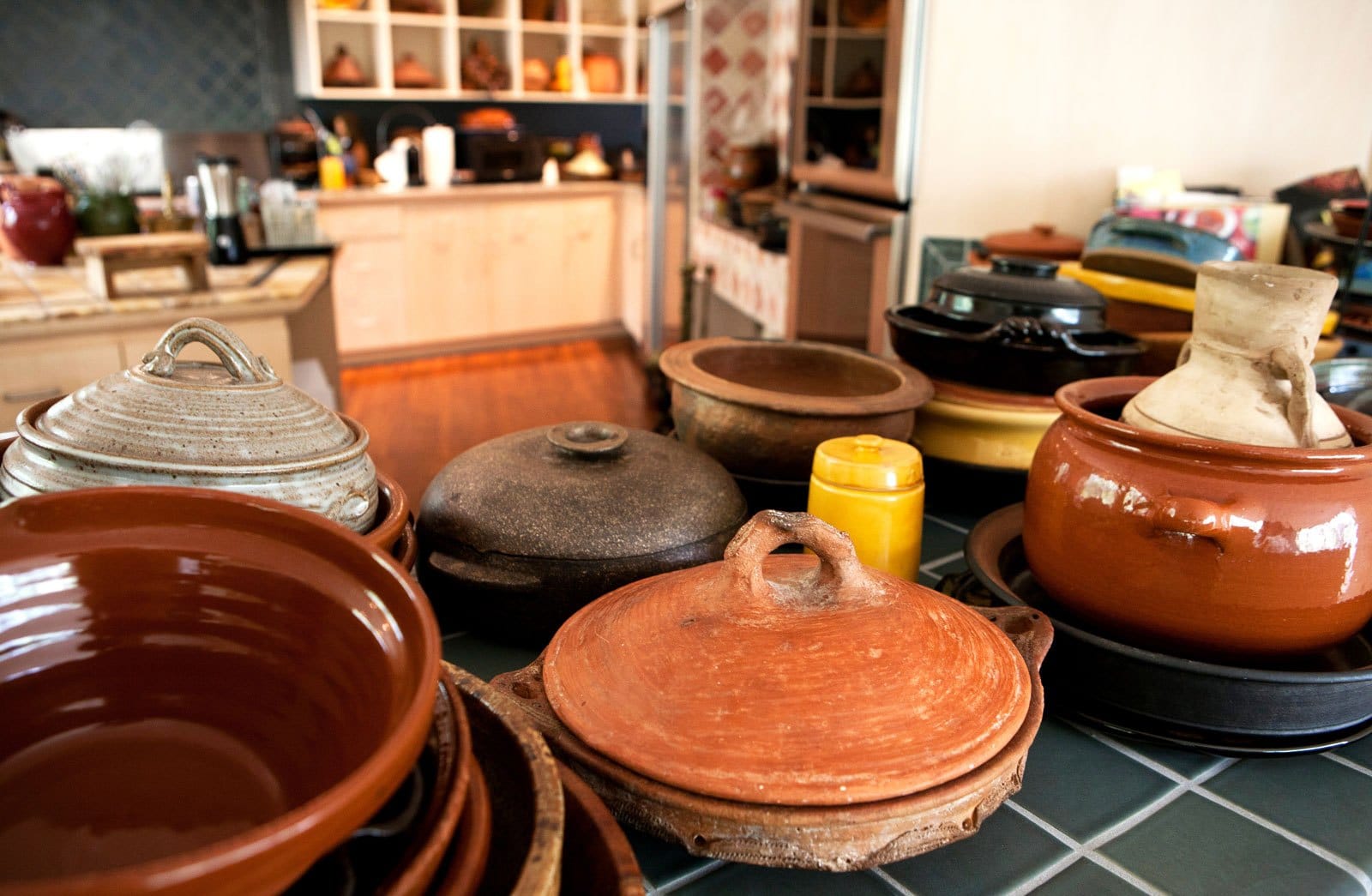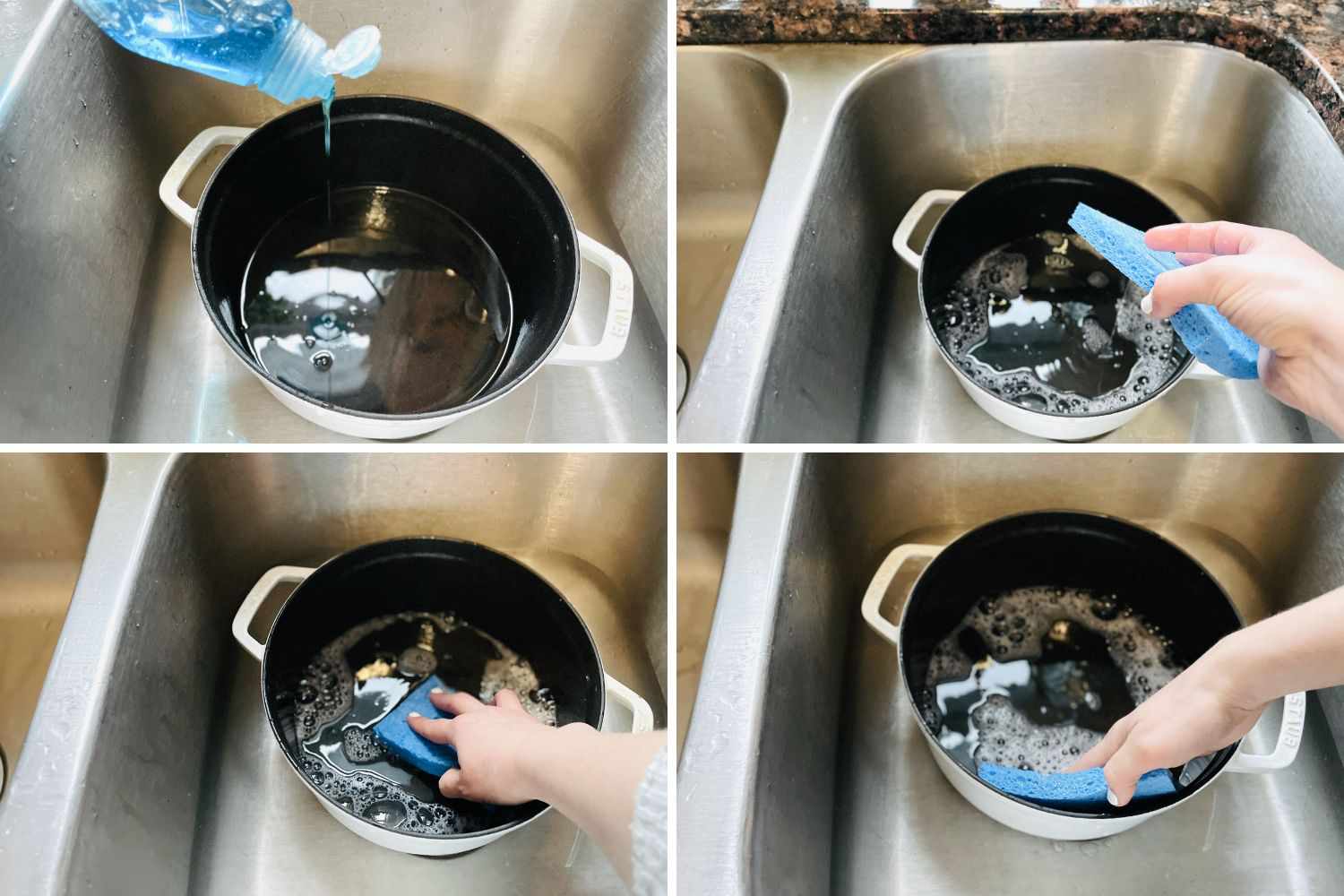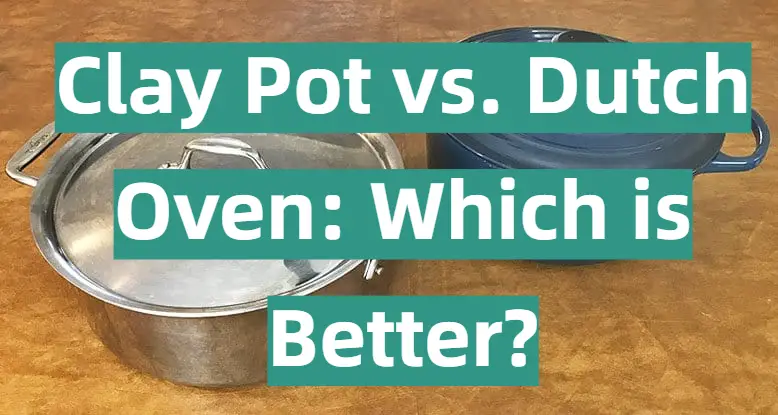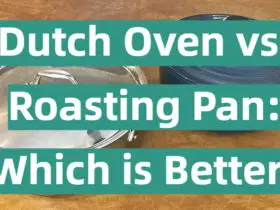When it comes to cooking, there are a lot of choices when it comes to choosing the right pot for your recipe. Two popular options that you may have heard of are clay pots and Dutch ovens. Since each option has its own set of pros and cons, how do you decide which one to choose? In this article, we will compare the two and help you decide which is better for your needs. We will consider various factors like heat retention, durability, portability, and ease of cleaning.
This will help you make an informed decision on which option is most suitable for your kitchen requirements. So let’s get started!
What is a Clay Pot?
A clay pot is a vessel made from clay and then fired in an oven or kiln, which has been used traditionally. These pots are used for boiling or steaming foods, as well as for baking bread and other dishes. They have thick walls that retain the heat, allowing them to cook food slowly and evenly while preserving moisture. The shape of these pots also helps with the even cooking, as the heat is evenly distributed throughout the entire pot.

Benefits Of A Clay Pot
A clay pot is a traditional cooking vessel made from natural clay. Clay pots can absorb flavors because of their porous nature, making them suitable for marinades and slow-cooking dishes such as soups, stews, and braises. Unlike other cookware materials, such as metals like aluminum and stainless steel, the porous nature of the clay pot keeps the food warm for a longer period of time.
Additionally, when it comes to cooking with acidic ingredients like tomatoes, clay pots are ideal since they absorb some of the acidity and prevent it from affecting the flavor of the meal. Clay pots also offer health benefits. Because clay is naturally non-reactive, there are no chemicals that can leach into the food. Additionally, clay is known to help reduce inflammation and aid in detoxification.
Drawback Of A Clay Pot
A clay pot is a slow cooker, which means that it can take a long time to cook the food. The cooking process is much slower than with a Dutch oven, and the simmering may be too low for some recipes, such as stews or soups. In addition, clay pots are also more labor-intensive, as they must be watched and stirred more often to prevent burning or overcooking. They also require a longer preheating time, which can add more time to meal preparation. Clay pots tend to be less durable than Dutch ovens and are prone to cracking if not cared for properly. [1]
What is a Dutch Oven?
The cooking vessel known as a Dutch oven is a cast iron pot that typically has three or four legs, a lid, and a lip around the top. This cooking tool is suitable for both indoor and outdoor use because it is extremely sturdy and can handle high temperatures. Dutch ovens are suitable for slow-cooking stews, casseroles and soups.

Benefits Of A Dutch Oven
A Dutch oven offers a number of advantages over clay pots. It is an ideal choice for stovetop or oven cooking, as it can retain heat very well and evenly distribute it throughout the pot. Cast iron cookware also enhances the flavor of dishes, providing them with a distinct and delectable taste.
Furthermore, Dutch ovens are highly resilient and only need minimal upkeep, which makes them ideal for prolonged utilization.
Drawback Of A Dutch Oven
Discover the benefits and limitations of a Dutch oven – a spacious, lidded pot crafted from durable materials such as cast iron. Ideal for simmering and braising, this kitchen staple facilitates low heat cooking with ease. But before you invest, learn about its potential drawbacks. While a Dutch oven is ideal for slow-cooking and braising, its heavy weight can present some challenges when it comes to maneuvering and storing it.
The lid of a Dutch oven can also pose a potential hazard due to its thickness and material. In contrast, clay pots are lightweight and easy to handle, making them a popular option for those who prioritize ease of use in the kitchen.
Although Dutch ovens are excellent for slow-cooking and braising, they are limited in terms of their versatility in the kitchen. Unlike clay pots, they cannot be used for rapid boiling or low heat simmering. While they possess many benefits, they may not always be the best option for certain cooking scenarios. However, their unique qualities make them ideal for specific culinary requirements. The choice between a Dutch oven and a clay pot for cooking depends on the kind of cooking you intend to do. [2]
Clay Pot vs Dutch Oven: Which is Best for Grilling?

Are you undecided between using a clay pot or a Dutch oven for grilling? Look no further. We’ve compared the two popular cooking methods so you can make an informed decision on which one suits your grilling needs. Read on to find out which is the better option for you.
Clay Pots
Discover the timeless cooking vessel – the clay pot. With their versatile shapes and sizes, clay pots have been a cooking staple for centuries. What’s more, they retain moisture like no other cookware, perfect for slow-cooking delicious moist dishes such as casseroles or stews.
Plus, they keep your food warm longer than other pots and pans. Clay pots may easily break if dropped or mishandled, which is their major drawback. They are also comparatively weighty, which makes them harder to maneuver in the kitchen. Moreover, the glazed surfaces on clay pots tend to discolor over time, detracting from their overall appearance.
Dutch Ovens
Looking for a pot that can handle it all? Look no further than the Dutch oven! Made of cast iron, these pots are oven-safe and perfect for use over open flames. With thick walls and a hefty lid, they distribute heat evenly throughout the pot, making it great for slow-cooked dishes like stews, soups, and roasts. While they’re incredibly versatile, be sure to give your Dutch oven some extra care to keep it in tip-top shape. Learn about the history of Dutch ovens, dating back to the 17th century when cast iron was introduced in Europe.
These cooking marvels feature a three-legged design for easy campfire use, and boast a lid rim that completely covers the pot. The benefits of owning a Dutch oven are numerous as it evenly distributes heat, retains it well, is more durable than clay pots, and can be used on both the stovetop and in the oven. [3]
The Differences Between Clay Pots and Dutch Ovens
Learn about the unique methods of clay pots and Dutch ovens in cooking. While clay pots have stood the test of time with their handmade craftsmanship, Dutch ovens utilize modern technology. Discover the benefits and differences in these cooking vessels.

Material
Discover the difference between clay pots and Dutch ovens. Clay is a traditional material used for cooking, known for retaining heat and enhancing flavor. On the other hand, Dutch ovens are typically made from cast iron. The porous nature of clay allows for moisture and flavor to be absorbed and released during cooking. Start exploring these age-old cooking essentials today.
One advantage of clay pots is that they can be used directly over an open fire, unlike Dutch ovens which need a surface that is flame-proof.
Cast iron is an incredibly sturdy material that ensures even heat distribution and temperature retention. These attributes make it the perfect option for sluggish cooking recipes such as soups, stews, and roasts. Dutch ovens take heat retention to the next level, which is ideal for baking bread or cakes. While they can be pricier than clay pots, they can last a lifetime if maintained correctly.
Design
Clay pots may look artsy but they aren’t as practical as Dutch ovens when it comes to cooking. Their free-form design fails to trap heat and retain moisture as effectively as the heavy-duty construction of Dutch ovens. Clay pots permit steam to escape due to their ‘breathing’ design, whereas Dutch ovens with their airtight lids trap heat and moisture within. Moreover, clay pots necessitate continuous lifting and stirring of the contents to avoid burning, unlike Dutch ovens that can be left unattended for more extended periods. [4]
Cooking Style
If you’re stuck between using a clay pot versus a Dutch oven for cooking, your preferred cooking style is the deciding factor. Clay pots are perfect for slow, low-heat cooking techniques such as roasting and braising. Clay gradually absorbs heat and distributes it evenly, resulting in mouth-watering food that stays moist and flavorful.
Alternatively, Dutch ovens excel with high-heat cooking methods such as boiling, baking, frying, and sautéing. Thanks to their enameled surfaces, food browns evenly without sticking, and the secure lid locks in moisture, keeping your food tender and delicious.
Heat Distribution
Discover the key difference between a clay pot and a Dutch oven – heat distribution. Clay pots are permeable which allows heat to gradually diffuse into the pot and its contents. Making them perfect for slow-cooked dishes like soups and stews that require low temperatures for optimal taste. Clay pots also retain moisture well, so dishes cooked in them tend to be extra juicy and flavorful.
On the other hand, Dutch ovens are typically constructed out of cast iron or enameled steel. These materials have excellent heat-conductivity, which means that the oven will reach a desired temperature quickly and hold onto it for a longer period of time.
Dutch ovens are ideal for dishes that need to be cooked at high temperatures for a long time, such as roasts and braises. Dutch ovens also do a better job of searing meat, so they make excellent choices for dishes such as pot roast or chili.
Cleaning and Maintenance
Both clay pots and Dutch ovens require some effort for cleaning and maintenance. Clay pots should be washed carefully with warm, soapy water and not subjected to drastic temperature changes or overly harsh abrasives. Dutch ovens can also be cleaned with warm, soapy water but may need additional elbow grease depending on the amount of residue left behind. Both pieces should be dried completely before storing them in a dry, cool place to prevent rust or other damage.

In addition, Dutch ovens also require seasoning every few months to make sure the oil layer is not diminished and the metal remains protected from corrosion. [5]
FAQ
Can I use a Dutch oven instead of a clay pot?
Yes, you can use a Dutch oven in place of a clay pot. Slow-cooking and baking are suitable for both options, therefore the choice relies on personal preference. A Dutch oven is typically made of metal with a tight-fitting cover, whereas a clay pot is usually unglazed terracotta or porcelain and has an open top.
A Dutch oven conducts heat more quickly and evenly than the thick walls of a clay pot, making it better suited for recipes that require quick cooking. It’s also easier to clean because you can put it in the dishwasher after each use.
The unique flavor of dishes cooked in a clay pot is due to the porous nature of the pot that allows flavors to seep into the food during cooking. In the end, it’s up to you to decide which type of cookware is best suited for your recipe and cooking needs.
Is it better to cook in a clay pot or cast iron?
The answer to this question really depends on what you’re looking for in your cooking experience. Clay pots are a great choice for slow cooked dishes, as they retain and disperse heat evenly over long periods of time while allowing moisture to escape. They also offer excellent insulation, so the food won’t overcook or burn easily. Although clay pots are prone to cracking if not handled carefully, they still need to be handled with care.
However, if taken care of properly, Dutch ovens last for years due to their exceptional durability. These cooking pots have a variety of sizes to fit every meal, are perfect for simmering soups and stews, and distribute heat evenly. They are also ideal for braising meats. They’re also easy to clean and relatively inexpensive.
Is it better to cook in a clay pot?
If you’re in the market for a cooking vessel, the answer to what to choose may depend on your needs.
For centuries, clay pots have been utilized by cooks all over the world due to their excellent heat retention and flavor preservation abilities. This makes them ideal for recipes that require slow cooking or roasting as it keeps moisture intact while preventing flavors from escaping. Clay pots are also cost-effective and can be purchased from most home stores.
Additionally, they are visually appealing and can add a decorative touch to any kitchen.
What’s better than a Dutch oven?
Discover the benefits of cooking with a clay pot! While a Dutch oven is commonly used for slow-cooking, clay pots have been a popular choice for centuries. Unlike Dutch ovens, clay pots require no pre-seasoning, making them easy to use right away. Plus, clay provides better and more even heat distribution, which reduces unwanted hot spots. Moreover, clay pots retain moisture better than Dutch ovens, resulting in more flavorful dishes with less evaporation.
Try a clay pot for your next slow-cooking adventure. Choosing clay pots for outdoor cooking is a great option because they are lightweight and easy to carry. The verdict is clear on whether to use a clay pot or Dutch oven for slow cooking: clay pots are the better option. Considering a clay pot is definitely worth it if you want a simple and convenient way to prepare your slow-cooked meals.
Do chefs use Dutch ovens?
Discover why the Dutch oven is a beloved kitchen essential among chefs and home cooks! This versatile cookware piece is perfect for slow-cooking, braising, and stewing as its unique shape allows for even heat distribution throughout the pot. Its thick walls aid in moisture retention, making it perfect for stews, roasts, and other hearty dishes that require longer cook times. Even baking bread is a breeze with a Dutch oven, as its lid traps moisture in while still promoting proper steam circulation.
Get ready to elevate your cooking game with a Dutch oven! Discover the perfect cooking vessel for your needs with a range of sizes and materials to choose from.
Clay pots are increasingly popular due to their unique ability to retain moisture while cooking. Ideal for slow-cooked dishes like stews, soups and braises, clay pots keep your food moist and flavorful, producing a texture that many chefs adore. Experience crispy and perfectly-baked bread and cakes with clay pots. Thanks to the clay’s ability to absorb and retain moisture, your baked goods will have a delightful crust. The best part? Cleaning and maintaining clay pots is a breeze. Choose from a variety of sizes and designs to find your ideal fit.
Is a clay pot oven safe?
For centuries, people have used a traditional clay pot oven as a cooking method. Clay pots are safe to use in the oven because they are made from fired clay and can withstand high temperatures. The heat distribution is even, so food cooks evenly without burning or scorching. Keep your meals perfectly cooked without the risk of burnt or scorched food with even heat distribution and the durability to withstand sudden temperature changes.
Crafted from high-quality clay, our pots are designed to keep food warm long after it’s cooked, ensuring your dishes are served at the perfect temperature every time. Plus, you won’t have to worry about any pesky cracks or breaks, giving you peace of mind when cooking or serving.
What should you not use a Dutch oven for?
When choosing a cooking pot, it is important to understand the limitations of each one. Not all types of cooking are suitable for Dutch ovens, so it’s important to avoid using them in specific situations. Dutch ovens can be challenging to use for preparing delicate dishes such as custards and flans because they retain heat better than other pots.
They are also not ideal for deep-frying because it is difficult to maintain the correct temperature without burning food. It is not advisable to use Dutch ovens for stovetop cooking as they need high heat which can cause damage to the pot in the long run.
Can you put a clay pot directly on the stove?
Do not ever put a clay pot directly on the stove! These pots are unprotected and their porous surface can easily break if exposed to direct heat. Instead, to cook with a clay pot, use indirect heat sources such as an oven or embers from a fire. Keep your cooking and your pots safe!
Dutch ovens are specifically made for cooking over a stove or campfire using direct heat. Cast iron or enamel-coated cast iron is used to make them, and they retain heat better than clay pots. This makes them ideal for searing meats, braising vegetables, baking breads and casseroles, and simmering stews and sauces. You can use Dutch ovens both on the stovetop and in the oven.
Why are clay pots the best?
For countless years, clay pots have been an indispensable item in any kitchen, valued for their ability to prepare sumptuous stews, soups, and desserts. They possess an exceptional set of characteristics that make them a top preference for both home cooks and professional chefs. Clay pots are the secret to keeping your food warm and delicious. Not only do they retain heat better than other vessels, but they also ensure that your meal is cooked evenly.
Moreover, the distinct flavors of clay pot dishes result from the absorption of minerals from the material they are made of.
Why are clay pots better?
For centuries, clay pots have been used to cook food and are still considered valuable in many cultures. These items are strong and durable because they are made of natural clay that is fired at high temperatures. Clay pots have tight-fitting lids that create a seal preventing moisture from escaping. This allows the food to slowly simmer in its own juices. Using this method to cook your meals slowly is a great option, as it helps to preserve more of the nutrients and flavors in the food. This makes it perfect for dishes that require longer cooking times, like soups, stews, curries, roasts, beans, and other heartier meals.
Clay pots are also better at evenly distributing heat than metal containers such as Dutch ovens or cast iron pans which can cause hot spots and lead to burnt food.
Additionally, the natural properties of clay make it resistant to bacteria, making it much safer to cook with than metal.
Why does food taste better in clay pots?
For many centuries, people have used clay pots to cook food because they preserve the natural flavors of the ingredients. Even today, they remain a popular choice. The porous walls of clay pots allow steam to escape while cooking, which results in moist and flavorful dishes.
Additionally, the slow and even heat distribution provided by clay ensures that your food is cooked evenly without burning or drying out. Clay pots also tend to be naturally non-stick, so there’s no need for added fat or oil when cooking certain dishes. This is ideal for people who prioritize their health and those who want to cut down on the use of unhealthy oils and fats while cooking.
Useful Video: CLAY POT OR DUTCH OVEN
Conclusion
Choosing between a clay pot and a Dutch oven can be difficult, but it’s important to understand the unique advantages that each has to offer. Clay pots are easier to transport and store, while Dutch ovens provide a more even temperature distribution and can be used for baking as well as cooking traditional dishes. Ultimately, the choice depends on personal preferences as well as the type of food being cooked. Both types of cookware can make delicious meals if used correctly. With the right recipes and techniques, either type of cookware can deliver impressive results in any kitchen setting.
References
- https://kitchenoa.com/clay-pot-vs-dutch-oven/
- https://miriamsearthencookware.com/mec-blog/best-dutch-oven-2/
- https://worldofpans.com/dutch-oven-substitute/
- https://forum.breadtopia.com/t/cast-iron-or-clay-baker/18033
- https://www.americastestkitchen.com/cooksillustrated/how_tos/5417-is-a-clay-cooker-better













Leave a Reply